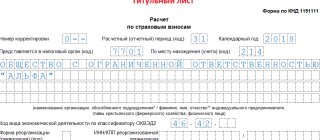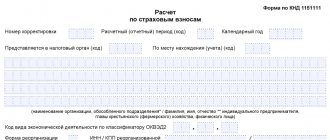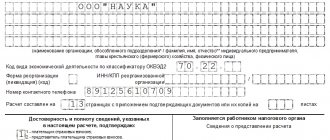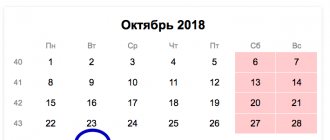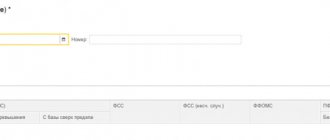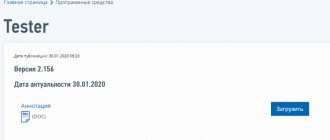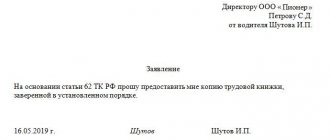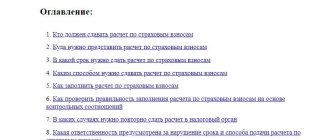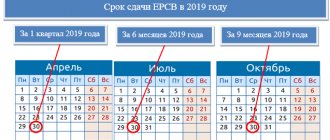What are they for?
Code numbers approved by the Federal Tax Service help inspection specialists quickly and accurately process data from unified calculations of contributions. Basically, they characterize parameters that provide complete information about an economic entity and, if necessary, allow you to classify the submitted report.
Of course, many accountants are accustomed to the codes in the RSV-1 calculation. In 2021, due to a change in the report format, their composition was updated, but the general approach is the same. They are located on the following parts of the single calculation:
- title;
- information about an individual without individual entrepreneur status;
- Section I;
- Section II;
- Section III.
Please note that some codes are entered by a tax official. But basically the responsibility rests with the enterprise. Therefore, it is important to understand which codes should be used when calculating insurance premiums in 2019 and how to indicate them correctly.
First of all, we will consider the features of filling out codes on the title page - billing period, reporting option, etc.
When completing a single calculation of contributions, follow the procedure for filling it out, which is established by Order of the Ministry of Finance No. ММВ-7-11/551 dated October 10, 2016.
How to include non-contributory expenses in your calculations
The manner in which such amounts are reflected in the report depends on whether they are recognized as an object of contributions or not. Thus, payments that are not attributable to the object of taxation should not be included in the calculation. If payments are an object, but are not subject to contributions in accordance with the provisions of Art. 422 of the Code, they should be reflected in the form.
The calculation indicates the taxable base. It is defined as the difference between the accrued payments, which are included in the object of taxation, and the amounts exempted from them under Art. 422 of the Tax Code of the Russian Federation.
Letter of the Federal Tax Service of the Russian Federation dated 08.08.2017 No. GD-4-11/ [email protected]
Note:
Examples of non-taxable amounts are, for example, rent paid to an individual for property rented from him, as well as child care benefits for up to 1.5 years.
However, the amount of rent is not shown in the calculation, since such payments are not the subject of contributions (clause 4 of Article 420 of the Tax Code of the Russian Federation). Also they are not named in Art. 422 of the Tax Code of the Russian Federation.
And the benefit paid to the employee is reflected in the calculation.
After all, the object of taxation with insurance premiums for payers, unless otherwise provided by Art. 420 of the Tax Code of the Russian Federation, payments and other remuneration in favor of individuals subject to compulsory social insurance are recognized (clause 1 of Article 420 of the Tax Code of the Russian Federation). Separately Art. 422 of the Tax Code of the Russian Federation provides for exceptions, that is, payments that are not subject (exempt) to insurance premiums. In particular, these include monthly benefits for child care up to 1.5 years.
What codes to use for reporting and billing periods?
A single calculation must be submitted after the 1st quarter, 6, 9 and 12 months. The deadline is no later than the 30th day of the month following such reporting period. The combination of numbers informing tax authorities about the reporting period is defined in Appendix No. 3 of the procedure for filling out a single calculation:
As you can see, the billing period is a year. It corresponds to code 34.
EXAMPLE
submits reports on contributions for the first quarter of 2021. When drawing up the first sheet in the field for reporting and billing periods, she notes the number 21:
What is the penalty for being late with the report and payment of fees?
Delay in submitting the calculation will result in a fine under Art. 119 of the Tax Code of the Russian Federation in the amount of 5 percent of the amount of insurance premiums not paid on time, subject to payment (surcharge) on the basis of this calculation, for each full or partial month from the day established for its submission. The upper fine is limited to 30 percent of the specified amount, the lower - 1 thousand rubles.
Therefore, if all contributions are paid on time, then for late payment the fine will be 1 thousand rubles.
Please note: violation of the deadlines for submitting the DAM for the reporting period also faces a fine under Art. 119 of the Tax Code of the Russian Federation, reclassify the violation under Art. 126 will not work in this case. Read the latest decision of the Federal Tax Service.
For officials, this offense is subject to a warning or an administrative fine in the amount of 300 to 500 rubles (Article 15.5 of the Code of Administrative Offenses of the Russian Federation).
In accordance with the current norms of the Tax Code of the Russian Federation, the tax authorities have no grounds for blocking an account if the deadlines for submitting reports on contributions are violated (letter of the Federal Tax Service of the Russian Federation dated May 10, 2017 No. AS-4-15/8659).
Penalties under paragraph 1 of Art. 122 of the Tax Code of the Russian Federation are relied upon for non-payment of insurance premiums due to an understatement of the base for them. If the company has correctly calculated the insurance premiums, but is in no hurry to pay them, then it will only be charged a penalty for the delay.
Fine under Art. 120 of the Tax Code of the Russian Federation for gross violation of taxation objects, income and expenses also applies to the base for contributions. Accordingly, for these gross violations, resulting in an underestimation of the base for contributions, a fine under Art. 120 of the Tax Code of the Russian Federation in the amount of 20 percent of unpaid contributions, but not less than 40 thousand rubles.
Code of the tax authority to which the report was submitted
Depending on the territorial location, tax inspectorates are assigned an individual number. You can find it out on the official website of the Federal Tax Service of Russia, from accounting reference books, or take the first four digits of the TIN.
The table shows values for some regions:
| Region of Russia | IFTS/MIFNS code |
| Moscow | 77— |
| Moscow region | 50— |
| Saint Petersburg | 78— |
| Tyumen region | 72— |
| Novosibirsk region | 54— |
| Amur region | 28— |
Where: “–” is the serial number of the tax authority in the region.
Location code
The field for this code is located on the title page to the right of the Federal Tax Service code. It is indicated depending on the territorial location of the enterprise and its legal status. The values can be as follows:
EXAMPLE
Let's assume that Guru LLC is located in Russia - in Tomsk. Then in the field in question they put the number 214, and the Federal Tax Service code is 7017:
Activity code
On the title page, after the name of the organization, you must indicate the code of economic activity - according to OKVED2. It contains information about the name of the company’s field of activity and a description of the grouping of its specific activities. You can view its value:
- in the all-Russian classifier;
- certificate of registration of an economic entity.
EXAMPLE
The scope of activity of Guru LLC is the production of armored and reinforced safes, as well as fire-resistant doors. According to the 2nd edition of the Classifier, the type of activity in question is assigned code 25.99.21. It is indicated in the corresponding field of the title page:
What codes to indicate for methods of submitting calculations for insurance premiums?
There are different options for submitting a single calculation of contributions to the Tax Service. Can personally bring the document, send it by mail or telecommunications networks. After receipt, the inspection itself puts down a code depending on the method chosen by the enterprise. This must be done by an employee of the Federal Tax Service. Possible values are presented in the table:
Code of type of reorganization or liquidation
When there is a process of termination of the activity of an economic entity, the creation of one/several companies or other changes related to legal succession, the corresponding code is indicated in a single calculation of insurance premiums. Its possible values are specified in Appendix No. 2 of the procedure for filling out the calculation:
If there are no actions related to reorganization or liquidation, a dash is placed in the appropriate field.
How to fill out section 3 of the RSV
When filling out section 3 “Personalized information about insured persons” of the calculation of insurance premiums, the following must be taken into account.
The fields “Last name” and “First name”, “Citizenship (country code)” must be filled in.
If the insured person is a citizen of the Russian Federation, then the full name (patronymic (if any)) field should be filled in as follows:
- fields are filled with uppercase (capital) and lowercase letters (including the letter ё) of the Russian alphabet (Cyrillic), and capital (capital) letters are also allowed: I, V of the Latin alphabet;
- fields must not contain numbers or punctuation marks (except for “.” (dot), “-” (hyphen), “'” (apostrophe), " " (space);
Invalid in “Last Name”:
- presence of the symbol "." (dot), "-" (hyphen), "'" (apostrophe), " " (space) as the first, last, or only character;
Inadmissible in First Name, Patronymic:
- the presence of the symbol "-" (hyphen), "'" (apostrophe), " " (space) as the first, last character or only character;
- location of the "." (dot) after the symbol “-” (hyphen);
- presence of the symbol "." (dot) as the first or only character;
- arrangement of two or more characters in a row: “.” (dot), “-” (hyphen), “’” (apostrophe), “” (space);
- presence of consecutive characters: “.” (dot), “-” (hyphen), “’” (apostrophe) or combinations thereof;
- the presence of lowercase letters of the Latin alphabet (I, V), as well as the use of these letters as the first or only character.
Field “TIN in the Russian Federation”:
- checking for the length and correctness of the TIN check number (including filling data with arbitrary technical values starting with 0000000000, 1234567890, etc.).
- the “TIN” indicator should contain only numbers;
- contain 12 characters;
- the value indicated in positions 1 to 4 corresponds to the tax authority code (according to the SOUN classifier);
- checking for the absence in the “TIN in the Russian Federation” field of values from the list “00”, “90”, “93”, “94”, “95”, “96”, “98” in the first two digits.
The “SNILS” indicator must consist of 11 digits in the format XXX-XXX-XXX-XX or XXX-XXX-XXX XX, where X takes numeric values from 0 to 9.
Field “Document series and number”, if it is a passport of a citizen of the Russian Federation (code 21):
- this structure should have the form “XX XX XXXXXX”, where X takes numeric values from 0 to 9 (series separated by a space).
Field "date of birth":
- the date must not exceed the current one;
- The year of birth must not be less than or equal to 1900.
Letter of the Federal Tax Service of the Russian Federation dated December 21, 2017 No. GD-4-11/ [email protected] “On the procedure for filling out the relevant details contained in section 3 “Personalized information about insured persons” of the Calculation of insurance premiums”
What codes to indicate in information about an individual without individual entrepreneur status
On the second page of the reporting in question, it is necessary to indicate the code of the country of citizenship. A list of all values is presented in the All-Russian Classifier of Countries of the World (Resolution of the State Standard of the Russian Federation No. 529-st).
Here are examples of some positions:
| The name of the country | Digital code |
| Russia | 643 |
| Belarus | 112 |
| Kazakhstan | 398 |
| Kyrgyzstan | 417 |
| Estonia | 233 |
In the section about the address of residence, indicate the code of the region of Russia in which the person is registered. When writing, follow Appendix No. 7 for the procedure for filling out a single calculation.
Insurance tariff: table of codes for calculating premiums
When submitting an invoice, be sure to indicate the tariff code. It characterizes the payer category, as well as a number of related characteristics.
In total, the legislation provides for 29 such codes. All of them are presented in the table below (Appendix No. 5):
| 1 | Payers of insurance premiums for OSN and applying the basic tariff of insurance premiums |
| 2 | Payers using the simplified tax system and applying the basic tariff |
| 3 | Payers on UTII and applying the basic tariff |
| 4 | Payers are business entities and business partnerships whose activities involve the practical application (implementation) of the results of intellectual activity (programs for electronic computers, databases, inventions, utility models, industrial designs, selection achievements, topologies of integrated circuits, production secrets (know-how) how), the exclusive rights to which belong to the founders (participants) (including jointly with other persons) of such business entities, participants of such economic partnerships - budgetary scientific institutions and autonomous scientific institutions or educational organizations of higher education that are budgetary institutions, autonomous institutions |
| 5 | Payers of insurance premiums who have entered into agreements with the management bodies of special economic zones on the implementation of technology-innovation activities and make payments to individuals working in a technology-innovation special economic zone or industrial-production special economic zone, as well as payers of insurance premiums who have entered into agreements on the implementation tourism and recreational activities and making payments to individuals working in tourist and recreational special economic zones, united by a decision of the Government of the Russian Federation into a cluster |
| 6 | Payers carrying out activities in the field of IT (with the exception of organizations that have entered into agreements with the management bodies of special economic zones on the implementation of technology-innovation activities and making payments to individuals working in a technology-innovation special economic zone or industrial production zone) |
| 7 | Payers of insurance premiums who make payments and other remuneration to crew members of ships registered in the Russian International Register of Ships for the performance of labor duties of a ship crew member |
| 8 | Payers of insurance premiums applying the simplified taxation system, and the main type of economic activity, which is specified in subparagraph 5 of paragraph 1 of Article 427 of the Code |
| 9 | Payers of insurance premiums who pay a single tax on imputed income for certain types of activities and have a license for pharmaceutical activities - in relation to payments and remunerations made to individuals who, in accordance with the Federal Law, have the right to engage in pharmaceutical activities or are allowed to carry them out |
| 10 | Payers of insurance premiums are non-profit organizations (with the exception of state (municipal) institutions), registered in the manner established by the legislation of the Russian Federation, applying a simplified taxation system and carrying out activities in accordance with the constituent documents in the field of social services for the population, scientific research and development, education, healthcare, culture and art (activities of theatres, libraries, museums and archives) and mass sports (except professional) |
| 11 | Payers of insurance premiums are charitable organizations registered in accordance with the procedure established by the legislation of the Russian Federation and applying the simplified tax system |
| 12 | Payers of insurance premiums are individual entrepreneurs who apply the patent taxation system in relation to payments and rewards accrued in favor of individuals engaged in the type of economic activity specified in the patent, with the exception of individual entrepreneurs carrying out the types of business activities specified in subparagraphs 19, 45 - 47 paragraph 2 of article 346.43 of the Tax Code of the Russian Federation |
| 13 | Payers of insurance premiums who have received the status of participants in the Skolkovo project |
| 14 | Payers of insurance premiums who have received the status of participant in the free economic zone in Crimea |
| 15 | Payers of insurance premiums who have received the status of resident of the territory of rapid socio-economic development |
| 16 | Payers of insurance premiums who have received resident status of the free port of Vladivostok |
| 21 | Payers of insurance premiums paying insurance premiums at additional rates established by paragraph 1 of Article 428 of the Code |
| 22 | Payers of insurance premiums paying insurance premiums at additional rates established by paragraph 2 of Article 428 of the Code |
| 23 | Payers of insurance premiums paying insurance premiums at additional rates established by paragraph 3 of Article 428 of the Code when establishing the class of working conditions - dangerous, subclass of working conditions - 4 |
| 24 | Payers of insurance premiums who pay insurance premiums at additional rates established by paragraph 3 of Article 428 of the Code when establishing the class of working conditions - harmful, subclass of working conditions - 3.4 |
| 25 | Payers of insurance premiums paying insurance premiums at additional rates established by paragraph 3 of Article 428 of the Code when establishing the class of working conditions - harmful, subclass of working conditions - 3.3 |
| 26 | Payers of insurance premiums paying insurance premiums at additional rates established by paragraph 3 of Article 428 of the Code when establishing the class of working conditions - harmful, subclass of working conditions - 3.2 |
| 27 | Payers of insurance premiums paying insurance premiums at additional rates established by paragraph 3 of Article 428 of the Code when establishing the class of working conditions - harmful, subclass of working conditions - 3.1 |
| 28 | Payers of insurance premiums paying insurance premiums for additional social security specified in paragraph 1 of Article 429 of the Code |
| 29 | Payers of insurance premiums paying insurance premiums for additional social security specified in paragraph 2 of Article 429 of the Code |
Please note that when filling out Appendix 1 of Section I, the combination of numbers 21 to 29 is not used in line 001 if several tariffs were in effect during the period. That is, the appropriate number of Appendix 1 (or its subsections) should be completed. Each of them must contain the required tariff.
EXAMPLE
applies the basic taxation regime and deducts contributions at the basic rate. This means that in line 001 of Appendix 1 of Section I, she notes code 01:
The absence of a tariff code in the zero RSV is not an error
Based on the results of a desk audit of the zero DAM, the inspectorate established a violation of the deadline for submitting the calculation. In particular, the initially submitted calculation contained an error - line 001 of Appendix 1 to Section 1 “Payer Tariff Code” was not filled in. The inspectorate did not accept this calculation. The DAM with amendments was submitted after the deadline had expired.
For this reason, the company was fined. Since the fine was not paid voluntarily, the tax authority decided to collect it from the funds in the taxpayer’s bank account.
Having disagreed with the decision of the tax authorities, the company went to court, and three instances supported it (Resolution of the Moscow District Arbitration Court dated March 10, 2020 No. F05-2548/2020).
The courts explained that paragraph 7 of Art. 431 of the Tax Code of the Russian Federation provides the grounds on which the DAM is recognized as unrepresented. The characteristics listed in this norm relate to information about specific individuals - recipients of payments.
In the case under consideration, there was no data on individuals in the zero calculation. Accordingly, failure to indicate the payer's tariff code cannot be an error when drawing up a zero calculation, since the company does not apply any tariff in the absence of payments.
What codes to use for document types?
The single calculation also includes a code that informs about the type of document identifying the insured. The designation used also depends on the presence of Russian citizenship and the status of the employee. Full information is presented below (Appendix No. 6 to the order of the Federal Tax Service No. ММВ-7-11/551):
These codes indicate:
- in information about an individual without individual entrepreneur status;
- in personal data about the insured (page 140 of Section 3).
EXAMPLE
In the personalized accounting information, the company reflected information about employee N.V. Maneev on the basis of a temporary identity card issued to a citizen of the Russian Federation. In such a situation, in line 140 you must specify code “14”:
Insured person category codes
The category codes of the insured person also help to simplify the processing of the information contained in the calculation. They are assigned to groups of people when they meet certain conditions. These could be employees who work in particularly difficult conditions, are engaged in intellectual activities, etc.
The meaning of the code usually depends on the nationality and tariffs at which contributions are calculated. A complete list of these codes can be seen in Appendix No. 8 to the procedure for filling out a single calculation.
EXAMPLE
When using the basic tariff, the organization making payments for a foreigner temporarily residing in the Russian Federation indicates the code “VZHNR”. For holders of Russian passports, its value will be “NR”.
For more information about this, see “Insured Person Category Codes for 2021: Table with Explanation.”
Budget classification code
The corresponding 20-digit number is placed on some pages of Sections I and II. It allows you to correctly distribute cash receipts from contributions depending on their purposes:
- pension insurance (compulsory and at an additional rate);
- medical insurance (CHI);
- social security;
- additional social security;
- illness and motherhood.
EXAMPLE
prepares calculations for insurance premiums for the first 6 months of 2019. Which BCCs need to be reflected in the first section for compulsory pension and health insurance are shown below:
When filling out a single calculation, use the new BCCs in force in 2021. Since the Federal Tax Service is now in charge of controlling insurance premiums, some changes have occurred.
How to properly pay fines for late reporting
If there is still a delay in submitting the report, and a fine has been accrued, then it must be paid for each type of insurance separately.
A minimum fine of 1 thousand rubles is also imposed for failure to submit a zero calculation of contributions. This amount should be distributed to budgets based on the standards for splitting the basic tariff of 30 percent into certain types of compulsory social insurance (22 percent for compulsory social insurance, 5.1 percent for compulsory medical insurance, 2.9 percent for VNIM), namely:
- 22:30×1,000=733.33 rubles - to the Pension Fund of Russia;
- 5.1:30×1,000=170 rubles - to the FFOMS;
- 2.9:30×1,000=96.67 rubles - to the Federal Social Insurance Fund of the Russian Federation.
Letter of the Federal Tax Service of the Russian Federation dated June 30, 2017 No. BS-4-11/ [email protected] “On the issue of distribution among state extra-budgetary funds of the amounts of proceeds from penalties provided for in Article 119 of the Tax Code of the Russian Federation, and determining the date of calculation of these sanctions”
Working conditions class code
The indicator under consideration affects the amount of insurance premiums. Additional rates are provided for employees who work in difficult or hazardous conditions. When making a single calculation, in the “Working conditions class code” box of Subsection 1.3.2, enter the number 1 if the hazard subclass is 4. And codes 2, 3, 4 and 5 correspond to subclasses 3.4, 3.3, 3.2 and 3.1.
EXAMPLE
compiles a calculation of insurance premiums for the first half of 2021. When entering data about K.V. Kuznetsov, who works as an electric welder, must enter the number 4 in the “Class of working conditions” field in Subsection 1.3.2.
When the tax authorities consider the calculation not submitted
The calculation is considered not submitted if:
- information on the total amount of insurance premiums for compulsory health insurance does not correspond to information on the amount of calculated contributions for each insured person for the specified period. Line 061 in columns 3–5 of Appendix 1 of Section 1 of the calculation must coincide with the amounts of lines 240 of Section 3 for each month, respectively.
- Inaccurate personal data identifying insured individuals is indicated (full name - SNILS - Taxpayer Identification Number (if available).
Please note that since 2021, the list of critical errors in the RSV has become longer. In order to pass the RSV without problems, you must not make mistakes in the following columns of section 3:
210 - the amount of payments and other remuneration for each of the last three months of the reporting or billing period; 220 - the base for calculating pension contributions within the limit for the same months; 240 - the amount of calculated pension contributions within the limit for the same months; 250 - totals for columns 210, 220 and 240; 280 - the base for calculating pension contributions at the additional tariff for each of the last three months of the reporting or billing period; 290 - the amount of calculated pension contributions at the additional tariff for the same months; 300 - totals for columns 280, 290. The total data in the listed lines for all individuals must correspond to the summary data in subsections 1.1 and 1.3 of the calculation.
Moreover, if an accountant, when filling out the DAM, made a mistake in calculating health insurance contributions, then the tax authorities cannot refuse to accept the calculation. Such clarifications were published by the service.
Note:
the company will have the opportunity to correct itself: to do this, the day after receiving the calculation, the tax office must inform the company about inaccuracies in the calculation, and the latter will submit a calculation with reliable data.
The updated calculation will be considered accepted, and the date of its submission will be determined by the original date of submission, if it is submitted within the deadlines established by the Tax Code of the Russian Federation:
- when sent electronically - within 5 days, counting from the date of sending the notification in electronic form;
- when sending a paper payment - within 10 days from the date of sending the notification on paper (clause 7 of Article 431 of the Tax Code of the Russian Federation).
Other codes in the calculation of insurance premiums and their designation
Above we looked at the most important codes that appear in the unified calculation of contributions. But when filling out the sheets of this document, you can come across a number of additional digital combinations. Let's take a closer look at them.
OKTMO
In Sections I and II you need to indicate OKTMO. It characterizes the territorial affiliation of the municipality where contributions are paid. You can view its value:
- in the order of Rosstandart No. 159-st;
- on the official website of the Federal Tax Service of Russia.
EXAMPLE
For the Sokolniki municipal district of Moscow OKTMO 45315000. And for the Yukhnovsky district of the Kaluga region - 29650000.
Legal basis additional tariff
When deductions are made for additional tariffs, the basis must be indicated:
- when employees work in difficult conditions, contributions of 6% are assessed. In this case, enter the number “2” in the corresponding field;
- if the activity is associated with harmful working conditions, the additional payment is 9%. Indicate the number "1".
Basis for filling according to additional tariff
In Subsection 1.3.2, the enterprise will need to mark the attribute on the basis of which the additional tariff was established:
- if the decision was made based on the results of a special assessment, put “1”;
- based on the results of certification of workplaces - 2;
- when combining these bases – 3.
Sign of payments for illness and maternity
At the beginning of Appendix 2 of Section I, it is necessary to indicate the payment indicator:
Put “1” if you indicate contributions to be paid to the budget. And “2” if you show the amount of excess of expenses for payment of insurance coverage over calculated contributions for illnesses and maternity.
It is also placed at the end of this Appendix:
How to fill out the RSV when switching to direct payments from the Social Insurance Fund
Law dated December 29, 2020 No. 478-FZ abolished from this year the provisions of Law dated December 29, 2006 No. 255-FZ regarding the appointment and payment of benefits by employers, with the exception of benefits for the first three days of illness.
The new procedure, under which social security will be provided directly by the social insurance fund, was approved by Resolution of the Cabinet of Ministers of the Russian Federation dated December 30, 2020 No. 2375 and will be in force throughout this year.
Since sickness and maternity benefits are now provided by the fund, policyholders no longer reduce their contributions for insurance costs.
In connection with the innovations, tax officials in a letter dated January 29, 2021 No. BS-4-11 / [email protected] reported that before adjusting the DAM form, starting from the first quarter of the current year, the calculation should be filled out taking into account the following features.
In Appendix 2 to Section 1 of the RSV:
- Column 070, where social security expenses are reflected, is not filled in;
- Column 080, required to indicate compensation from the Social Insurance Fund, is filled out only when the fund reimburses payments for previous periods - until 2021;
- line 090 does not indicate feature 2;
Appendices 3 and 4 to section 1 of the DAM are not completed.
